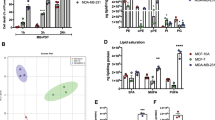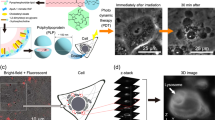Abstract
Photosensitizers (PS) are ideally devoid of any activity in the absence of photoactivation, and rely on molecular oxygen for the formation of singlet oxygen (1O2) to produce cellular damage. Off-targets and tumor hypoxia therefore represent obstacles for the use of PS for cancer photodynamic therapy. Herein, we describe the characterization of OR141, a benzophenazine compound identified through a phenotypic screening for its capacity to be strictly activated by light and to kill a large variety of tumor cells under both normoxia and hypoxia. This new class of PS unraveled an unsuspected common mechanism of action for PS that involves the combined inhibition of the mammalian target of rapamycin (mTOR) signaling pathway and proteasomal deubiquitinases (DUBs) USP14 and UCH37. Oxidation of mTOR and other endoplasmic reticulum (ER)-associated proteins drives the early formation of high molecular weight (MW) complexes of multimeric proteins, the concomitant blockade of DUBs preventing their degradation and precipitating cell death. Furthermore, we validated the antitumor effects of OR141 in vivo and documented its highly selective accumulation in the ER, further increasing the ER stress resulting from 1O2 generation upon light activation.
This is a preview of subscription content, access via your institution
Access options
Subscribe to this journal
Receive 50 print issues and online access
$259.00 per year
only $5.18 per issue
Buy this article
- Purchase on Springer Link
- Instant access to full article PDF
Prices may be subject to local taxes which are calculated during checkout






Similar content being viewed by others
References
Wilson BC, Patterson MS . The physics, biophysics and technology of photodynamic therapy. Phys Med Biol 2008; 53: R61–109.
Agostinis P, Berg K, Cengel KA, Foster TH, Girotti AW, Gollnick SO et al. Photodynamic therapy of cancer: an update. CA Cancer J Clin 2011; 61: 250–281.
Ormond AB, Freeman HS . Dye sensitizers for photodynamic therapy. Materials 2013; 6: 817–840.
Castano AP, Mroz P, Hamblin MR . Photodynamic therapy and anti-tumour immunity. Nat Rev Cancer 2006; 6: 535–545.
Mroz P, Yaroslavsky A, Kharkwal GB, Hamblin MR . Cell death pathways in photodynamic therapy of cancer. Cancers 2011; 3: 2516–2539.
Davies MJ . The oxidative environment and protein damage. Biochim Biophys Acta 2005; 1703: 93–109.
Davies MJ . Reactive species formed on proteins exposed to singlet oxygen. Photochem Photobiol Sci 2004; 3: 17–25.
Berlett BS, Stadtman ER . Protein oxidation in aging, disease, and oxidative stress. J Biol Chem 1997; 272: 20313–20316.
Donohue E, Tovey A, Vogl AW, Arns S, Sternberg E, Young RN et al. Inhibition of autophagosome formation by the benzoporphyrin derivative verteporfin. J Biol Chem 2011; 286: 7290–7300.
Turro NJ, Ramamurthy V, Scaiano JC . Modern molecular photochemistry of organic molecules. ChemPhysChem 2011; 13: 2496–2497.
Hiraoka W, Honda H, Feril Jr LB, Kudo N, Kondo T . Comparison between sonodynamic effect and photodynamic effect with photosensitizers on free radical formation and cell killing. Ultrason Sonochem 2006; 13: 535–542.
Hwang JY, Lubow DJ, Chu D, Sims J, Alonso-Valenteen F, Gray HB et al. Photoexcitation of tumor-targeted corroles induces singlet oxygen-mediated augmentation of cytotoxicity. J Control Release 2012; 163: 368–373.
Wilson WR, Hay MP . Targeting hypoxia in cancer therapy. Nat Rev Cancer 2011; 11: 393–410.
Semenza GL . Targeting HIF-1 for cancer therapy. Nat Rev Cancer 2003; 3: 721–732.
Poon E, Harris AL, Ashcroft M . Targeting the hypoxia-inducible factor (HIF) pathway in cancer. Expert Rev Mol Med 2009; 11: e26.
Wouters BG, Koritzinsky M . Hypoxia signalling through mTOR and the unfolded protein response in cancer. Nat Rev Cancer 2008; 8: 851–864.
Clarke HJ, Chambers JE, Liniker E, Marciniak SJ . Endoplasmic reticulum stress in malignancy. Cancer Cell 2014; 25: 563–573.
Ma Y, Hendershot LM . The role of the unfolded protein response in tumour development: friend or foe? Nat Rev Cancer 2004; 4: 966–977.
Udeshi ND, Mertins P, Svinkina T, Carr SA . Large-scale identification of ubiquitination sites by mass spectrometry. Nat Protoc 2013; 8: 1950–1960.
Cao Y, Li CY, Moeller BJ, Yu D, Zhao Y, Dreher MR et al. Observation of incipient tumor angiogenesis that is independent of hypoxia and hypoxia inducible factor-1 activation. Cancer Res 2005; 65: 5498–5505.
Draoui N, Schicke O, Seront E, Bouzin C, Sonveaux P, Riant O et al. Antitumor activity of 7-aminocarboxycoumarin derivatives, a new class of potent inhibitors of lactate influx but not efflux. Mol Cancer Ther 2014; 13: 1410–1418.
Diao Y, Liu W, Wong CC, Wang X, Lee K, Cheung PY et al. Oxidation-induced intramolecular disulfide bond inactivates mitogen-activated protein kinase kinase 6 by inhibiting ATP binding. Proc Natl Acad Sci USA 2010; 107: 20974–20979.
Nadeau PJ, Charette SJ, Toledano MB, Landry J . Disulfide Bond-mediated multimerization of Ask1 and its reduction by thioredoxin-1 regulate H(2)O(2)-induced c-Jun NH(2)-terminal kinase activation and apoptosis. Mol Biol Cell 2007; 18: 3903–3913.
van der Wijk T, Overvoorde J, den Hertog J . H2O2-induced intermolecular disulfide bond formation between receptor protein-tyrosine phosphatases. J Biol Chem 2004; 279: 44355–44361.
Jain A, Arauz E, Aggarwal V, Ikon N, Chen J, Ha T . Stoichiometry and assembly of mTOR complexes revealed by single-molecule pulldown. Proc Natl Acad Sci USA 2014; 111: 17833–17838.
Takahara T, Hara K, Yonezawa K, Sorimachi H, Maeda T . Nutrient-dependent multimerization of the mammalian target of rapamycin through the N-terminal HEAT repeat region. J Biol Chem 2006; 281: 28605–28614.
Brugarolas J, Lei K, Hurley RL, Manning BD, Reiling JH, Hafen E et al. Regulation of mTOR function in response to hypoxia by REDD1 and the TSC1/TSC2 tumor suppressor complex. Genes Dev 2004; 18: 2893–2904.
Li W, Petrimpol M, Molle KD, Hall MN, Battegay EJ, Humar R . Hypoxia-induced endothelial proliferation requires both mTORC1 and mTORC2. Circ Res 2007; 100: 79–87.
Nakatsukasa K, Brodsky JL . The recognition and retrotranslocation of misfolded proteins from the endoplasmic reticulum. Traffic 2008; 9: 861–870.
Brodsky JL . Cleaning up: ER-associated degradation to the rescue. Cell 2012; 151: 1163–1167.
Ng W, Sergeyenko T, Zeng N, Brown JD, Romisch K . Characterization of the proteasome interaction with the Sec61 channel in the endoplasmic reticulum. J Cell Sci 2007; 120: 682–691.
Liu X, Zheng XF . Endoplasmic reticulum and Golgi localization sequences for mammalian target of rapamycin. Mol Biol Cell 2007; 18: 1073–1082.
Seront E, Pinto A, Bouzin C, Bertrand L, Machiels JP, Feron O . PTEN deficiency is associated with reduced sensitivity to mTOR inhibitor in human bladder cancer through the unhampered feedback loop driving PI3K/Akt activation. Br J Cancer 2013; 109: 1586–1592.
Corbet C, Draoui N, Polet F, Pinto A, Drozak X, Riant O et al. The SIRT1/HIF2alpha axis drives reductive glutamine metabolism under chronic acidosis and alters tumor response to therapy. Cancer Res 2014; 74: 5507–5519.
Hiraoka W, Honda H, Feril Jr LB, Kudo N, Kondo T . Comparison between sonodynamic effect and photodynamic effect with photosensitizers on free radical formation and cell killing. Ultrason Sonochem 2006; 13: 535–542.
Yoshii H, Yoshii Y, Asai T, Furukawa T, Takaichi S, Fujibayashi Y . Photo-excitation of carotenoids causes cytotoxicity via singlet oxygen production. Biochem Biophys Res Commun 2012; 417: 640–645.
Sueishi Y, Hori M, Ishikawa M, Matsu-Ura K, Kamogawa E, Honda Y et al. Scavenging rate constants of hydrophilic antioxidants against multiple reactive oxygen species. J Clin Biochem Nutr 2014; 54: 67–74.
Altun M, Kramer HB, Willems LI, McDermott JL, Leach CA, Goldenberg SJ et al. Activity-based chemical proteomics accelerates inhibitor development for deubiquitylating enzymes. Chem Biol 2011; 18: 1401–1412.
Acknowledgements
This work was supported by grants from the Région Bruxelles Capitale (Innoviris), the Fonds national de la Recherche Scientifique (FRS-FNRS), the Belgian Foundation against cancer, the J Maisin Foundation, the interuniversity attraction pole (IUAP) research program #UP7-03 from the Belgian Science Policy Office (Belspo) and an Action de Recherche Concertée (ARC 14/19).
Author information
Authors and Affiliations
Corresponding authors
Ethics declarations
Competing interests
The authors declare no conflict of interest.
Additional information
Supplementary Information accompanies this paper on the Oncogene website
Rights and permissions
About this article
Cite this article
Pinto, A., Mace, Y., Drouet, F. et al. A new ER-specific photosensitizer unravels 1O2-driven protein oxidation and inhibition of deubiquitinases as a generic mechanism for cancer PDT. Oncogene 35, 3976–3985 (2016). https://doi.org/10.1038/onc.2015.474
Received:
Revised:
Accepted:
Published:
Issue Date:
DOI: https://doi.org/10.1038/onc.2015.474
This article is cited by
-
Deletion of the deISGylating enzyme USP18 enhances tumour cell antigenicity and radiosensitivity
British Journal of Cancer (2021)
-
A drug screening assay on cancer cells chronically adapted to acidosis
Cancer Cell International (2018)



